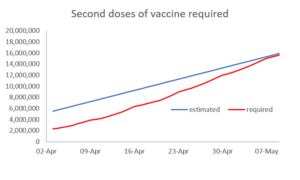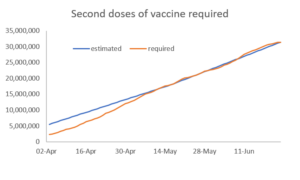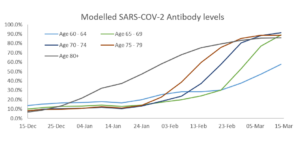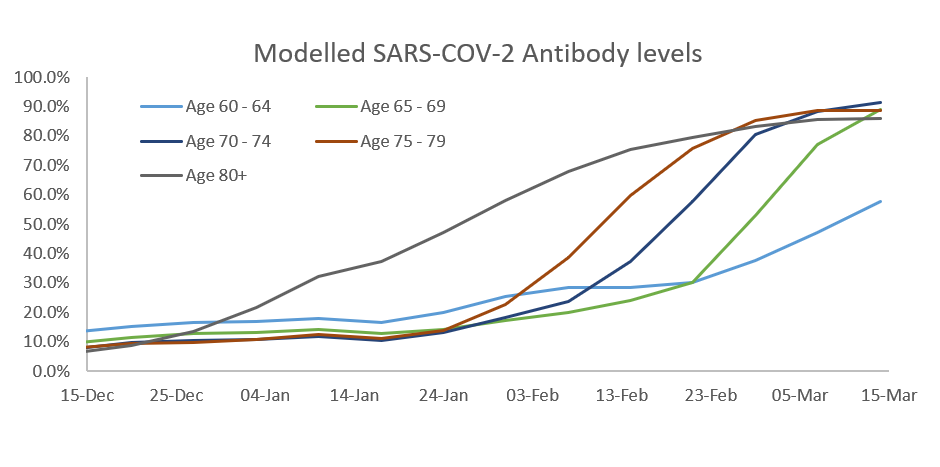8 April 2021
Lies, Damned Lies and Coronavirus
Second jabs!
by David Chilvers
 The UK continues to make excellent progress with the vaccination rollout. As of today (Wednesday 7th April), over 31.5 million adults had received at least one jab and over 5.5 million their second jab. With the programme having started in earnest in early January, the focus now is on providing the second jabs to those already inoculated.
The UK continues to make excellent progress with the vaccination rollout. As of today (Wednesday 7th April), over 31.5 million adults had received at least one jab and over 5.5 million their second jab. With the programme having started in earnest in early January, the focus now is on providing the second jabs to those already inoculated.
It is fairly straightforward to look at what is required to ensure that all individuals have their second jab within 12 weeks of their first. This can be done by moving all the first jab numbers forwards 12 weeks and estimating the cumulative requirement for second jabs and comparing this with the numbers undertaken.
The chart below shows the requirement to ensure all those in the first four cohorts receive their second jab by 9th May – 12 weeks after the deadline for these cohorts receiving their first jab – this is the red line shown below.

The blue line shows the number of second doses given or estimated, from where we are now, to hit the target by 9th May. As can be seen at present the number of second doses given is well ahead of the number required. To meet the target of the first four cohorts receiving their second jab by 9th May requires an average of 288,879 second jabs per day between now and then. So, anything above 300k vaccines available per day allows first doses to continue in the next cohort, those aged 40-49.
Boris Johnson has mentioned several times that vaccine supply will be constrained in April, not as high as in March but higher than February. In February, the UK averaged 404k vaccinations per day and in March this rose to 470k per day. So, if April is between these two figures, we might assume 425k per day. This is well in excess of the number needed to meet the second dose target by mid May and generates an estimated 3.75 million doses in April to be used on the next cohorts. There are 8.2 million people in the UK aged 40-49, so on this basis around half of them would receive their first jab by the end of April.0
We can extend this process and look at what would happen if this level of vaccine provision continued until the end of June, by which time second doses for all those in cohorts 5-9 would be required. If the vaccines available continued at 300k per day, this would be insufficient to meet the need of cohorts 5-9 for their second jab within 12 weeks. The shortfall is around 2.25 million doses and the daily requirement would need to go up from 300k per day to 360k per day from mid-May to ensure the target for 2nd jabs of all those aged 50-69 was met. The reason for this is that vaccine availability increased substantially in March and so the number of first doses administered each day increased substantially.

With vaccine availability at 300k until mid-May and 360k per day from mid-May until the end of June, the target for all of cohorts 1-9 to have their second jab within 12 weeks of their first jab would just be met. Any surplus above these figures again could be used on the next cohorts. The Government had originally expected supply levels to return to those achieved in March of around 500k per day from 1st May. However, in a report published by SAGE yesterday, these forecasts were downgraded to an estimated 2.7 million doses per week in England; this translates to around 450k per day for the UK as a whole.
Assuming 450k per day means a surplus of 150k per day for the first half of May and 90k per day from then onwards, generating a total over and above what is needed for second jabs of just over 5 million doses available for those aged under 50. Together with the surplus in April, on these assumptions (425k vaccines per day in April, 450k per day in May and June), this generates just under 9 million doses against a requirement of just over 16 million to vaccinate all those aged 18+ by the end of June. On these assumptions, it will therefore be about 16th July until all adults in the UK receive at least one dose. Some adults will refuse to be vaccinated and so the likely time to offer the vaccines to everyone will probably in practice be a little earlier than this date.
Up to now, the Government has met its vaccination targets. All those in the first four cohorts were offered a vaccine a couple of days before the 15th February deadline and all those in cohorts 1-9 will be covered before mid-April. This final target, of offering a vaccination to all adults by July also looks likely to be met, as long as the vaccine supply runs in line with our assumptions. And everyone, in theory, should be able to have their second jab within 12 weeks of their first jab (I say in theory as in practice the logistics of scheduling all the appointments required and then matching the right vaccine availability to the right sites is a complex exercise).
Finally, it’s worth looking at international comparisons on vaccine rollout. The “Our World in Data (OWID)” website provides information on the number of vaccinations undertaken by each country, which is updated on a daily basis. The time periods covered are not exactly the same for each country, but nevertheless the data source provides a useful way of comparing activity across different countries. In terms of the percentage of the population given at least one dose, the UK is in 8th position and second only to Israel in countries with a population of one million plus, as the table below shows (please note data shows vaccinations administered per head of population, not per adult, as the number of adults is not readily available in many countries).
| country | population | % one dose | % both doses | rank one dose |
| Gibraltar | 33,691 | 95.85% | 84.93% | 1 |
| Seychelles | 98,340 | 65.21% | 38.60% | 2 |
| Falkland Islands | 3,483 | 62.79% | 0.00% | 3 |
| Israel | 8,655,541 | 60.87% | 55.92% | 4 |
| Bhutan | 771,612 | 60.50% | 0.00% | 5 |
| Saint Helena | 6,071 | 51.18% | 0.00% | 6 |
| Cayman Islands | 65,720 | 46.57% | 30.67% | 7 |
| United Kingdom | 67,886,004 | 46.44% | 7.93% | 8 |
| Isle of Man | 85,032 | 46.02% | 18.05% | 9 |
| Jersey | 101,073 | 43.85% | 14.66% | 10 |
But in terms of full vaccination with both doses, the UK ranks in 21st place and is behind nine other countries with a population of one million plus.
| country | population | % one dose | % both doses | rank both doses |
| Israel | 8,655,541 | 60.87% | 55.92% | 2 |
| Chile | 19,116,209 | 36.31% | 20.12% | 7 |
| United States | 331,002,647 | 32.09% | 18.55% | 8 |
| Bahrain | 1,701,583 | 31.17% | 16.86% | 10 |
| Serbia | 6,804,596 | 21.70% | 16.03% | 11 |
| Morocco | 36,910,558 | 11.78% | 10.54% | 16 |
| Hungary | 9,660,350 | 24.46% | 9.45% | 17 |
| Turkey | 84,339,067 | 11.32% | 8.46% | 18 |
| Singapore | 5,850,343 | 17.95% | 8.00% | 20 |
| United Kingdom | 67,886,004 | 46.44% | 7.93% | 21 |
The gamble that the UK has taken is the assumption that the efficacy of two doses will not be diminished significantly by using a 12-week gap between doses, compared to the 3-4 weeks being used by most other nations and as recommended by the vaccine manufacturers. Time will tell on this, although early data on antibody prevalence among those already vaccinated suggests that this does not appear to diminish a lot over time.

This chart contains data modelled from the weekly ONS COVID Infection survey and shows the level of SARS-COV-2 antibodies by age group. Among the over 80’s, most of whom were vaccinated by late January, there is a gradual build up of antibodies towards the 80% level. The same level is reached later for the younger age groups that were vaccinated later. There is no evidence, so far, of antibody levels starting to decline, suggesting that extending the interval between doses does not dilute the level of protection. It will be interesting to see if antibody levels rise again once second doses start to be administered.
So, as far as vaccine performance is concerned, the UK is still on target to hit all its vaccination targets and using the extended gap between doses does not seem to reduce the impact of the vaccine and of course allows far more people to receive a first dose more quickly.
This article is one of a series, last week’s article on international comparisons is here.


